MBA501: Disruptive Innovation and Strategic Leadership
VerifiedAdded on 2022/10/12
|10
|2897
|111
Report
AI Summary
This report analyzes disruptive innovation and strategic leadership within the context of Essendon Food Solutions (EFS), examining its capacity to innovate from internal, external, marketing, and technological perspectives. The report delves into the internal structures impacting EFS's innovative capacity, including human resources, organizational culture, resource allocation, and organizational structure, and offers recommendations for improvement. It also evaluates the external environment, considering commitments, regulations, and their impact on innovation. Furthermore, the report analyzes marketing and customer-related factors, along with technological strategies. The analysis identifies challenges such as the lack of a structured marketing team and the aging R&D team, and proposes solutions like forming cross-functional teams and leveraging patent analysis. The report concludes by emphasizing the importance of a separate marketing team for global expansion and highlighting the significance of creative thinking and practical knowledge in product innovation strategy, all in the context of dynamic strategies.
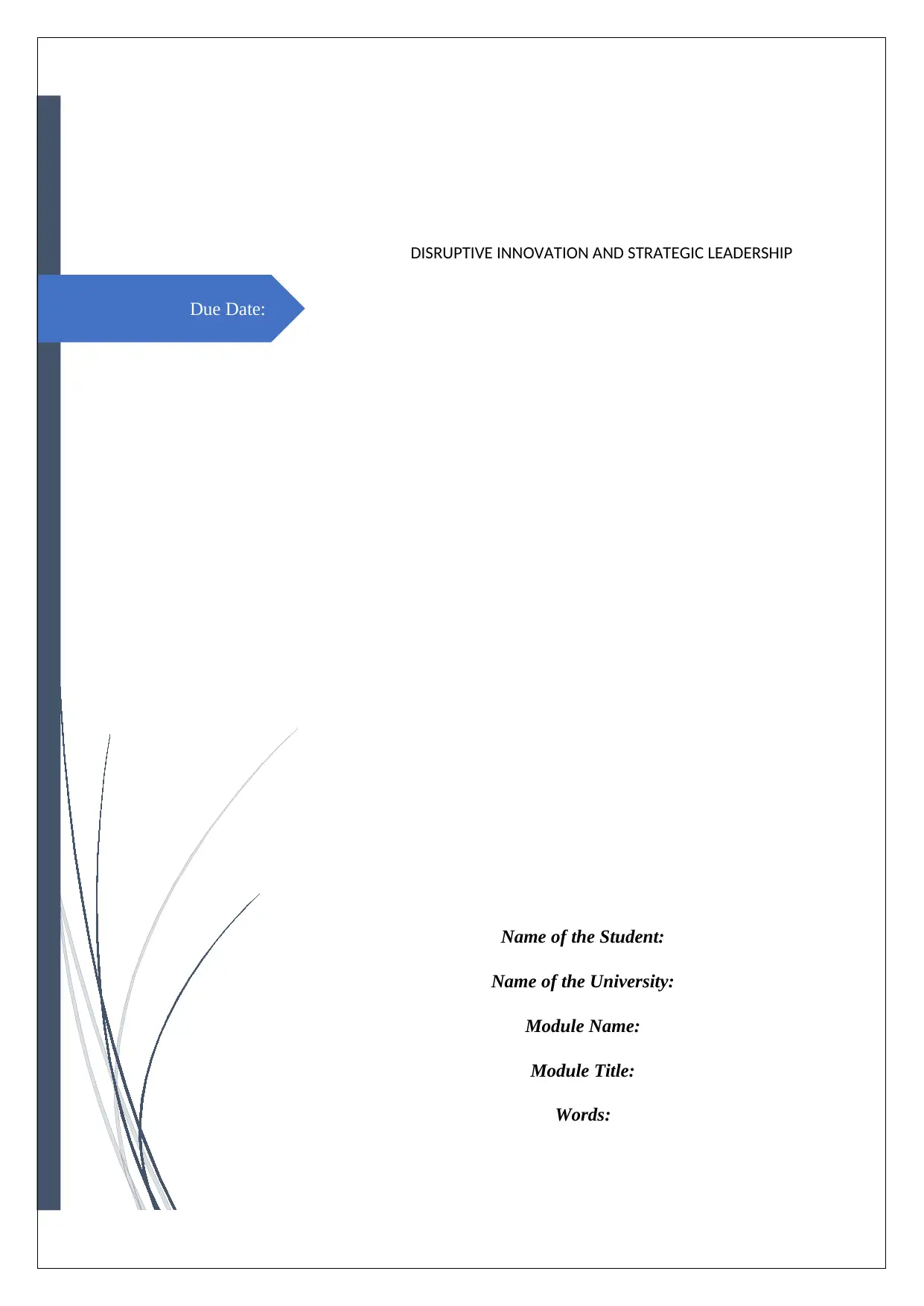
Due Date:
DISRUPTIVE INNOVATION AND STRATEGIC LEADERSHIP
Name of the Student:
Name of the University:
Module Name:
Module Title:
Words:
DISRUPTIVE INNOVATION AND STRATEGIC LEADERSHIP
Name of the Student:
Name of the University:
Module Name:
Module Title:
Words:
Paraphrase This Document
Need a fresh take? Get an instant paraphrase of this document with our AI Paraphraser
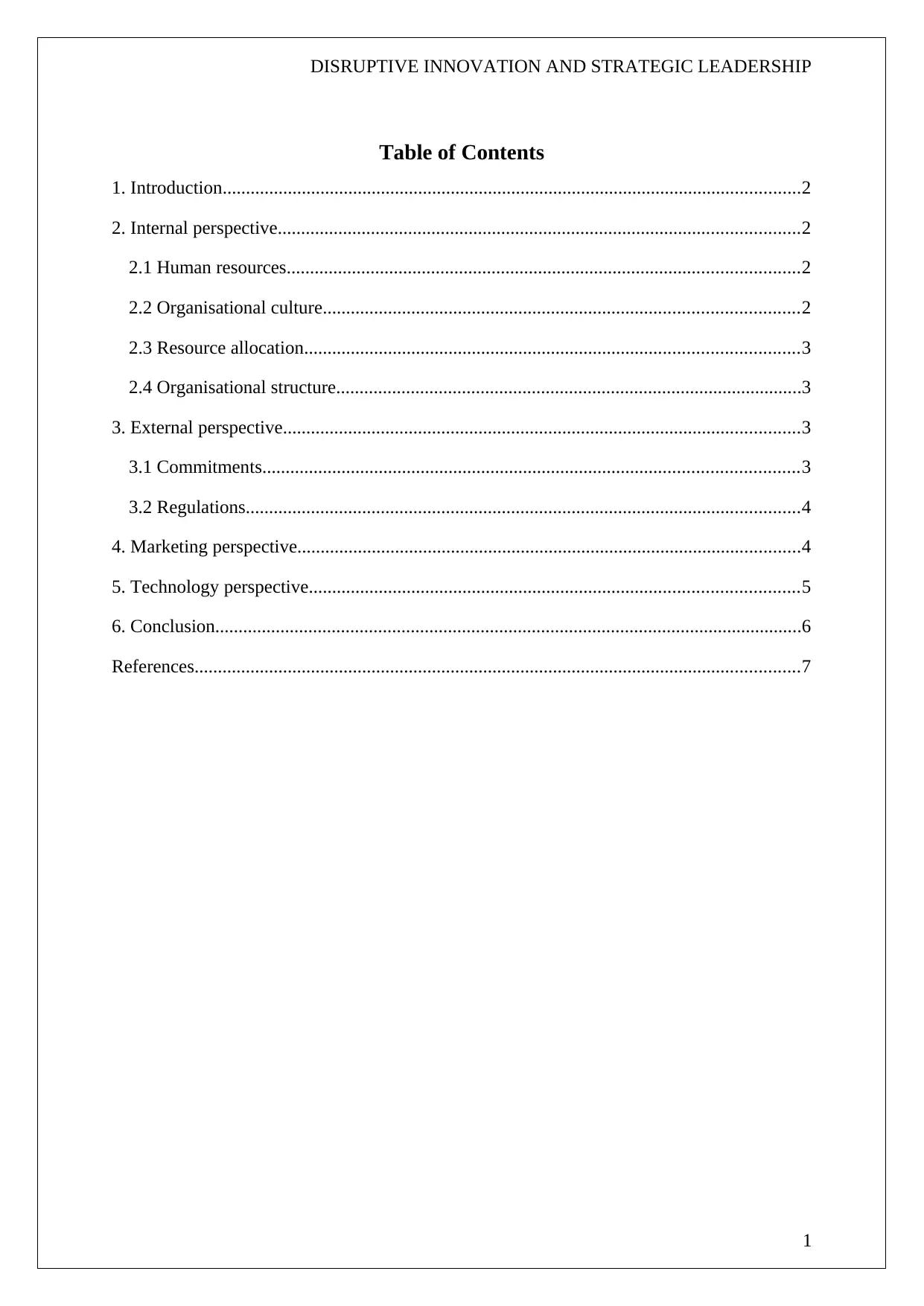
DISRUPTIVE INNOVATION AND STRATEGIC LEADERSHIP
Table of Contents
1. Introduction............................................................................................................................2
2. Internal perspective................................................................................................................2
2.1 Human resources..............................................................................................................2
2.2 Organisational culture......................................................................................................2
2.3 Resource allocation..........................................................................................................3
2.4 Organisational structure....................................................................................................3
3. External perspective...............................................................................................................3
3.1 Commitments...................................................................................................................3
3.2 Regulations.......................................................................................................................4
4. Marketing perspective............................................................................................................4
5. Technology perspective.........................................................................................................5
6. Conclusion..............................................................................................................................6
References..................................................................................................................................7
1
Table of Contents
1. Introduction............................................................................................................................2
2. Internal perspective................................................................................................................2
2.1 Human resources..............................................................................................................2
2.2 Organisational culture......................................................................................................2
2.3 Resource allocation..........................................................................................................3
2.4 Organisational structure....................................................................................................3
3. External perspective...............................................................................................................3
3.1 Commitments...................................................................................................................3
3.2 Regulations.......................................................................................................................4
4. Marketing perspective............................................................................................................4
5. Technology perspective.........................................................................................................5
6. Conclusion..............................................................................................................................6
References..................................................................................................................................7
1
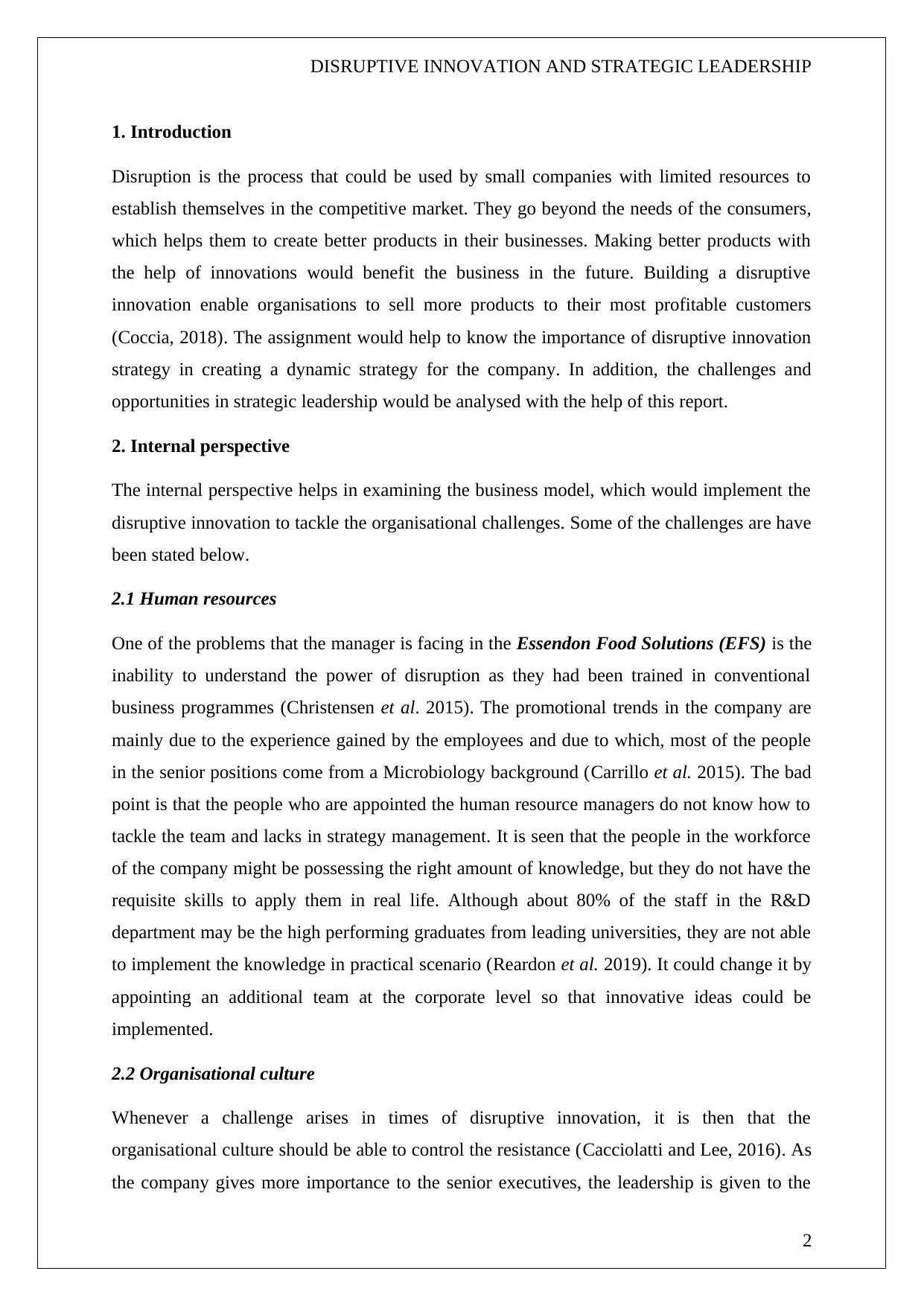
DISRUPTIVE INNOVATION AND STRATEGIC LEADERSHIP
1. Introduction
Disruption is the process that could be used by small companies with limited resources to
establish themselves in the competitive market. They go beyond the needs of the consumers,
which helps them to create better products in their businesses. Making better products with
the help of innovations would benefit the business in the future. Building a disruptive
innovation enable organisations to sell more products to their most profitable customers
(Coccia, 2018). The assignment would help to know the importance of disruptive innovation
strategy in creating a dynamic strategy for the company. In addition, the challenges and
opportunities in strategic leadership would be analysed with the help of this report.
2. Internal perspective
The internal perspective helps in examining the business model, which would implement the
disruptive innovation to tackle the organisational challenges. Some of the challenges are have
been stated below.
2.1 Human resources
One of the problems that the manager is facing in the Essendon Food Solutions (EFS) is the
inability to understand the power of disruption as they had been trained in conventional
business programmes (Christensen et al. 2015). The promotional trends in the company are
mainly due to the experience gained by the employees and due to which, most of the people
in the senior positions come from a Microbiology background (Carrillo et al. 2015). The bad
point is that the people who are appointed the human resource managers do not know how to
tackle the team and lacks in strategy management. It is seen that the people in the workforce
of the company might be possessing the right amount of knowledge, but they do not have the
requisite skills to apply them in real life. Although about 80% of the staff in the R&D
department may be the high performing graduates from leading universities, they are not able
to implement the knowledge in practical scenario (Reardon et al. 2019). It could change it by
appointing an additional team at the corporate level so that innovative ideas could be
implemented.
2.2 Organisational culture
Whenever a challenge arises in times of disruptive innovation, it is then that the
organisational culture should be able to control the resistance (Cacciolatti and Lee, 2016). As
the company gives more importance to the senior executives, the leadership is given to the
2
1. Introduction
Disruption is the process that could be used by small companies with limited resources to
establish themselves in the competitive market. They go beyond the needs of the consumers,
which helps them to create better products in their businesses. Making better products with
the help of innovations would benefit the business in the future. Building a disruptive
innovation enable organisations to sell more products to their most profitable customers
(Coccia, 2018). The assignment would help to know the importance of disruptive innovation
strategy in creating a dynamic strategy for the company. In addition, the challenges and
opportunities in strategic leadership would be analysed with the help of this report.
2. Internal perspective
The internal perspective helps in examining the business model, which would implement the
disruptive innovation to tackle the organisational challenges. Some of the challenges are have
been stated below.
2.1 Human resources
One of the problems that the manager is facing in the Essendon Food Solutions (EFS) is the
inability to understand the power of disruption as they had been trained in conventional
business programmes (Christensen et al. 2015). The promotional trends in the company are
mainly due to the experience gained by the employees and due to which, most of the people
in the senior positions come from a Microbiology background (Carrillo et al. 2015). The bad
point is that the people who are appointed the human resource managers do not know how to
tackle the team and lacks in strategy management. It is seen that the people in the workforce
of the company might be possessing the right amount of knowledge, but they do not have the
requisite skills to apply them in real life. Although about 80% of the staff in the R&D
department may be the high performing graduates from leading universities, they are not able
to implement the knowledge in practical scenario (Reardon et al. 2019). It could change it by
appointing an additional team at the corporate level so that innovative ideas could be
implemented.
2.2 Organisational culture
Whenever a challenge arises in times of disruptive innovation, it is then that the
organisational culture should be able to control the resistance (Cacciolatti and Lee, 2016). As
the company gives more importance to the senior executives, the leadership is given to the
2
⊘ This is a preview!⊘
Do you want full access?
Subscribe today to unlock all pages.

Trusted by 1+ million students worldwide
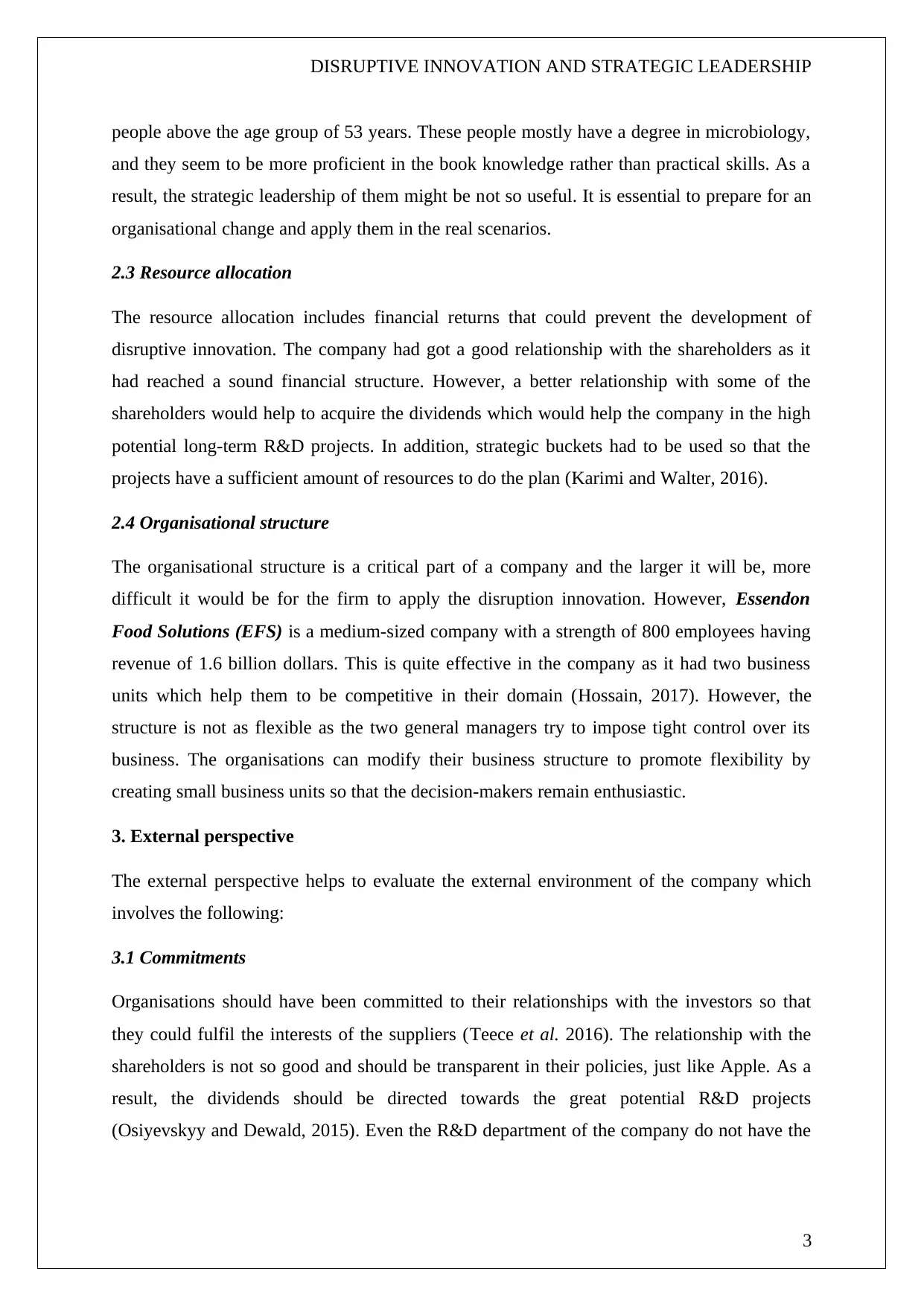
DISRUPTIVE INNOVATION AND STRATEGIC LEADERSHIP
people above the age group of 53 years. These people mostly have a degree in microbiology,
and they seem to be more proficient in the book knowledge rather than practical skills. As a
result, the strategic leadership of them might be not so useful. It is essential to prepare for an
organisational change and apply them in the real scenarios.
2.3 Resource allocation
The resource allocation includes financial returns that could prevent the development of
disruptive innovation. The company had got a good relationship with the shareholders as it
had reached a sound financial structure. However, a better relationship with some of the
shareholders would help to acquire the dividends which would help the company in the high
potential long-term R&D projects. In addition, strategic buckets had to be used so that the
projects have a sufficient amount of resources to do the plan (Karimi and Walter, 2016).
2.4 Organisational structure
The organisational structure is a critical part of a company and the larger it will be, more
difficult it would be for the firm to apply the disruption innovation. However, Essendon
Food Solutions (EFS) is a medium-sized company with a strength of 800 employees having
revenue of 1.6 billion dollars. This is quite effective in the company as it had two business
units which help them to be competitive in their domain (Hossain, 2017). However, the
structure is not as flexible as the two general managers try to impose tight control over its
business. The organisations can modify their business structure to promote flexibility by
creating small business units so that the decision-makers remain enthusiastic.
3. External perspective
The external perspective helps to evaluate the external environment of the company which
involves the following:
3.1 Commitments
Organisations should have been committed to their relationships with the investors so that
they could fulfil the interests of the suppliers (Teece et al. 2016). The relationship with the
shareholders is not so good and should be transparent in their policies, just like Apple. As a
result, the dividends should be directed towards the great potential R&D projects
(Osiyevskyy and Dewald, 2015). Even the R&D department of the company do not have the
3
people above the age group of 53 years. These people mostly have a degree in microbiology,
and they seem to be more proficient in the book knowledge rather than practical skills. As a
result, the strategic leadership of them might be not so useful. It is essential to prepare for an
organisational change and apply them in the real scenarios.
2.3 Resource allocation
The resource allocation includes financial returns that could prevent the development of
disruptive innovation. The company had got a good relationship with the shareholders as it
had reached a sound financial structure. However, a better relationship with some of the
shareholders would help to acquire the dividends which would help the company in the high
potential long-term R&D projects. In addition, strategic buckets had to be used so that the
projects have a sufficient amount of resources to do the plan (Karimi and Walter, 2016).
2.4 Organisational structure
The organisational structure is a critical part of a company and the larger it will be, more
difficult it would be for the firm to apply the disruption innovation. However, Essendon
Food Solutions (EFS) is a medium-sized company with a strength of 800 employees having
revenue of 1.6 billion dollars. This is quite effective in the company as it had two business
units which help them to be competitive in their domain (Hossain, 2017). However, the
structure is not as flexible as the two general managers try to impose tight control over its
business. The organisations can modify their business structure to promote flexibility by
creating small business units so that the decision-makers remain enthusiastic.
3. External perspective
The external perspective helps to evaluate the external environment of the company which
involves the following:
3.1 Commitments
Organisations should have been committed to their relationships with the investors so that
they could fulfil the interests of the suppliers (Teece et al. 2016). The relationship with the
shareholders is not so good and should be transparent in their policies, just like Apple. As a
result, the dividends should be directed towards the great potential R&D projects
(Osiyevskyy and Dewald, 2015). Even the R&D department of the company do not have the
3
Paraphrase This Document
Need a fresh take? Get an instant paraphrase of this document with our AI Paraphraser
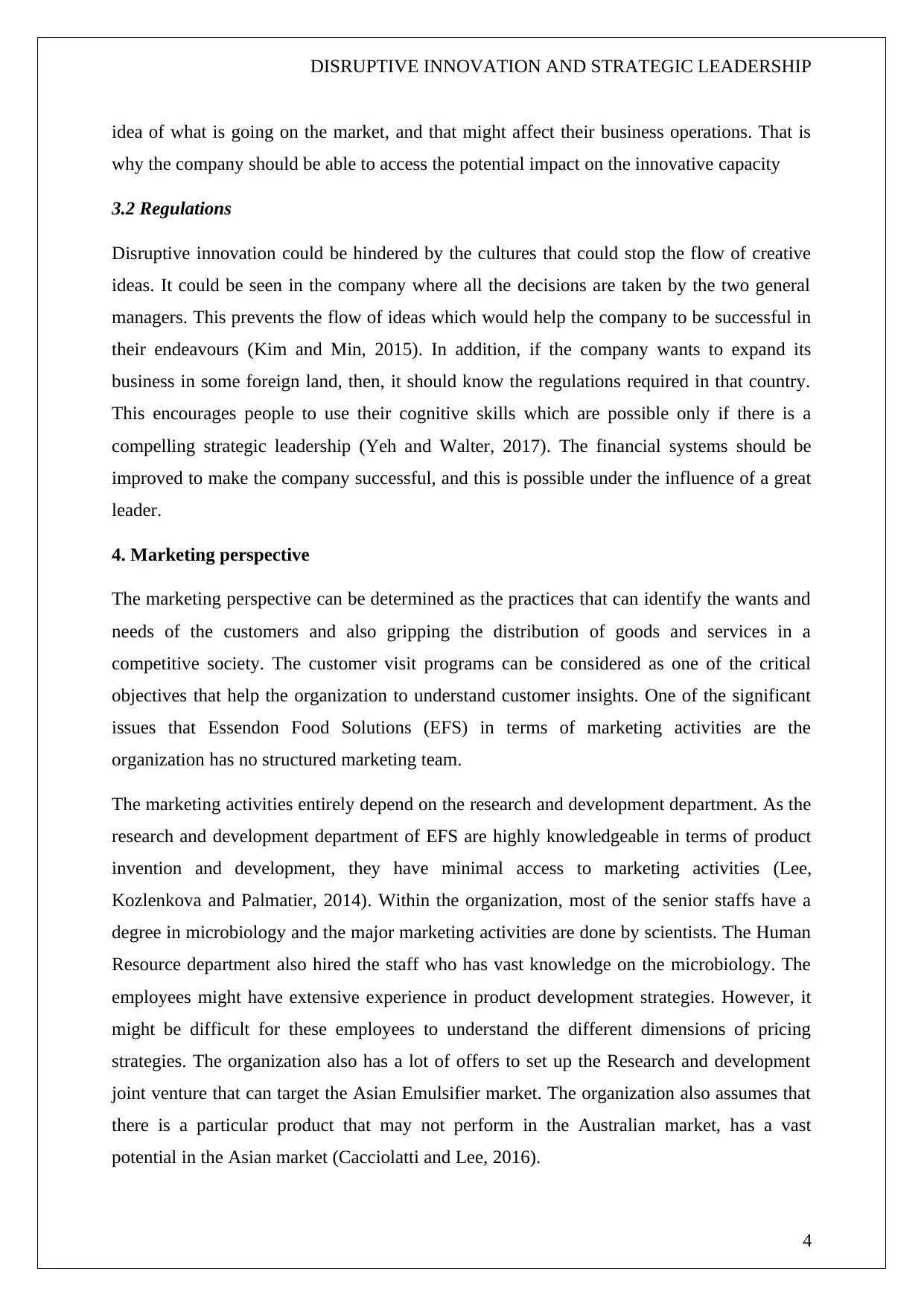
DISRUPTIVE INNOVATION AND STRATEGIC LEADERSHIP
idea of what is going on the market, and that might affect their business operations. That is
why the company should be able to access the potential impact on the innovative capacity
3.2 Regulations
Disruptive innovation could be hindered by the cultures that could stop the flow of creative
ideas. It could be seen in the company where all the decisions are taken by the two general
managers. This prevents the flow of ideas which would help the company to be successful in
their endeavours (Kim and Min, 2015). In addition, if the company wants to expand its
business in some foreign land, then, it should know the regulations required in that country.
This encourages people to use their cognitive skills which are possible only if there is a
compelling strategic leadership (Yeh and Walter, 2017). The financial systems should be
improved to make the company successful, and this is possible under the influence of a great
leader.
4. Marketing perspective
The marketing perspective can be determined as the practices that can identify the wants and
needs of the customers and also gripping the distribution of goods and services in a
competitive society. The customer visit programs can be considered as one of the critical
objectives that help the organization to understand customer insights. One of the significant
issues that Essendon Food Solutions (EFS) in terms of marketing activities are the
organization has no structured marketing team.
The marketing activities entirely depend on the research and development department. As the
research and development department of EFS are highly knowledgeable in terms of product
invention and development, they have minimal access to marketing activities (Lee,
Kozlenkova and Palmatier, 2014). Within the organization, most of the senior staffs have a
degree in microbiology and the major marketing activities are done by scientists. The Human
Resource department also hired the staff who has vast knowledge on the microbiology. The
employees might have extensive experience in product development strategies. However, it
might be difficult for these employees to understand the different dimensions of pricing
strategies. The organization also has a lot of offers to set up the Research and development
joint venture that can target the Asian Emulsifier market. The organization also assumes that
there is a particular product that may not perform in the Australian market, has a vast
potential in the Asian market (Cacciolatti and Lee, 2016).
4
idea of what is going on the market, and that might affect their business operations. That is
why the company should be able to access the potential impact on the innovative capacity
3.2 Regulations
Disruptive innovation could be hindered by the cultures that could stop the flow of creative
ideas. It could be seen in the company where all the decisions are taken by the two general
managers. This prevents the flow of ideas which would help the company to be successful in
their endeavours (Kim and Min, 2015). In addition, if the company wants to expand its
business in some foreign land, then, it should know the regulations required in that country.
This encourages people to use their cognitive skills which are possible only if there is a
compelling strategic leadership (Yeh and Walter, 2017). The financial systems should be
improved to make the company successful, and this is possible under the influence of a great
leader.
4. Marketing perspective
The marketing perspective can be determined as the practices that can identify the wants and
needs of the customers and also gripping the distribution of goods and services in a
competitive society. The customer visit programs can be considered as one of the critical
objectives that help the organization to understand customer insights. One of the significant
issues that Essendon Food Solutions (EFS) in terms of marketing activities are the
organization has no structured marketing team.
The marketing activities entirely depend on the research and development department. As the
research and development department of EFS are highly knowledgeable in terms of product
invention and development, they have minimal access to marketing activities (Lee,
Kozlenkova and Palmatier, 2014). Within the organization, most of the senior staffs have a
degree in microbiology and the major marketing activities are done by scientists. The Human
Resource department also hired the staff who has vast knowledge on the microbiology. The
employees might have extensive experience in product development strategies. However, it
might be difficult for these employees to understand the different dimensions of pricing
strategies. The organization also has a lot of offers to set up the Research and development
joint venture that can target the Asian Emulsifier market. The organization also assumes that
there is a particular product that may not perform in the Australian market, has a vast
potential in the Asian market (Cacciolatti and Lee, 2016).
4
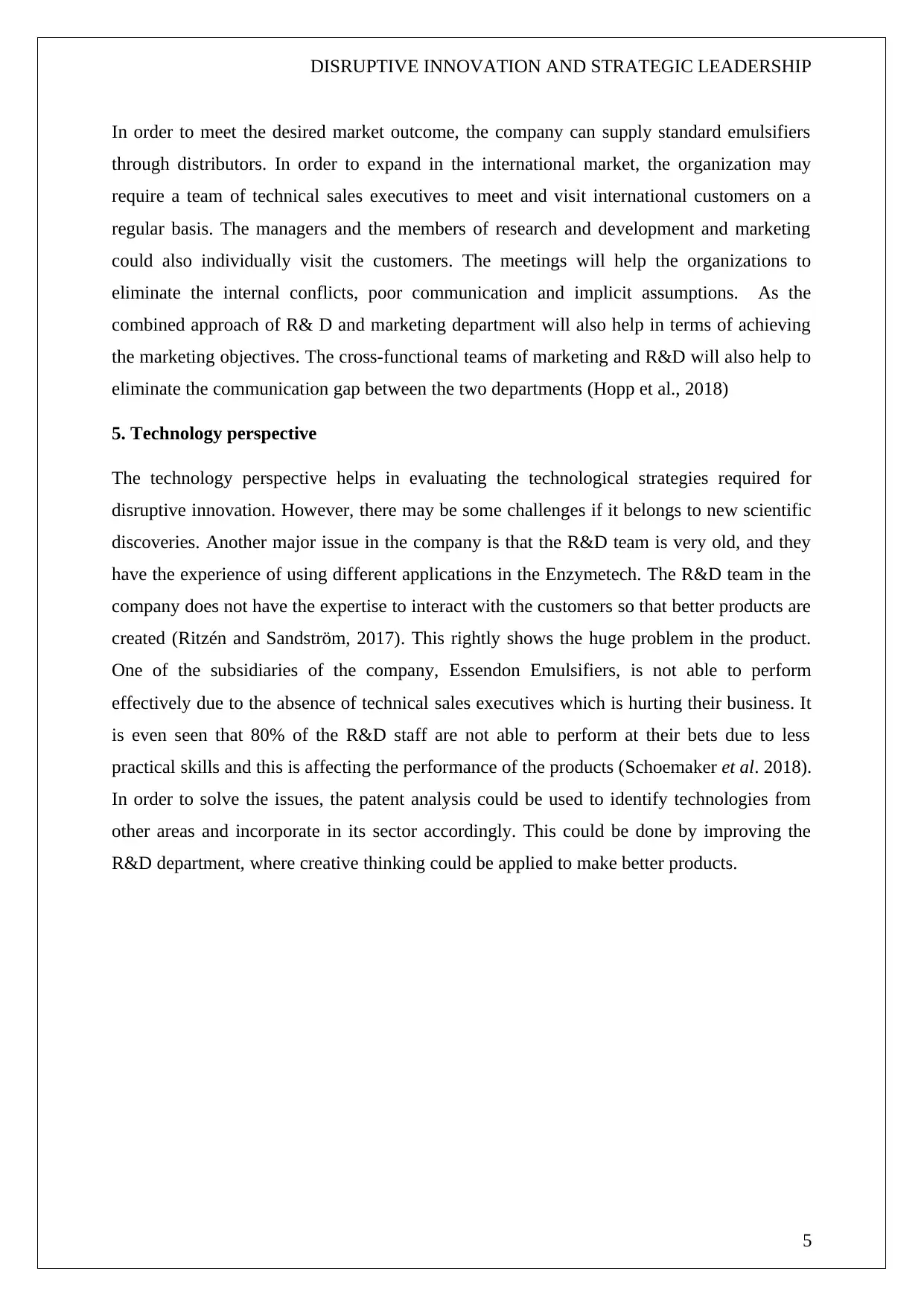
DISRUPTIVE INNOVATION AND STRATEGIC LEADERSHIP
In order to meet the desired market outcome, the company can supply standard emulsifiers
through distributors. In order to expand in the international market, the organization may
require a team of technical sales executives to meet and visit international customers on a
regular basis. The managers and the members of research and development and marketing
could also individually visit the customers. The meetings will help the organizations to
eliminate the internal conflicts, poor communication and implicit assumptions. As the
combined approach of R& D and marketing department will also help in terms of achieving
the marketing objectives. The cross-functional teams of marketing and R&D will also help to
eliminate the communication gap between the two departments (Hopp et al., 2018)
5. Technology perspective
The technology perspective helps in evaluating the technological strategies required for
disruptive innovation. However, there may be some challenges if it belongs to new scientific
discoveries. Another major issue in the company is that the R&D team is very old, and they
have the experience of using different applications in the Enzymetech. The R&D team in the
company does not have the expertise to interact with the customers so that better products are
created (Ritzén and Sandström, 2017). This rightly shows the huge problem in the product.
One of the subsidiaries of the company, Essendon Emulsifiers, is not able to perform
effectively due to the absence of technical sales executives which is hurting their business. It
is even seen that 80% of the R&D staff are not able to perform at their bets due to less
practical skills and this is affecting the performance of the products (Schoemaker et al. 2018).
In order to solve the issues, the patent analysis could be used to identify technologies from
other areas and incorporate in its sector accordingly. This could be done by improving the
R&D department, where creative thinking could be applied to make better products.
5
In order to meet the desired market outcome, the company can supply standard emulsifiers
through distributors. In order to expand in the international market, the organization may
require a team of technical sales executives to meet and visit international customers on a
regular basis. The managers and the members of research and development and marketing
could also individually visit the customers. The meetings will help the organizations to
eliminate the internal conflicts, poor communication and implicit assumptions. As the
combined approach of R& D and marketing department will also help in terms of achieving
the marketing objectives. The cross-functional teams of marketing and R&D will also help to
eliminate the communication gap between the two departments (Hopp et al., 2018)
5. Technology perspective
The technology perspective helps in evaluating the technological strategies required for
disruptive innovation. However, there may be some challenges if it belongs to new scientific
discoveries. Another major issue in the company is that the R&D team is very old, and they
have the experience of using different applications in the Enzymetech. The R&D team in the
company does not have the expertise to interact with the customers so that better products are
created (Ritzén and Sandström, 2017). This rightly shows the huge problem in the product.
One of the subsidiaries of the company, Essendon Emulsifiers, is not able to perform
effectively due to the absence of technical sales executives which is hurting their business. It
is even seen that 80% of the R&D staff are not able to perform at their bets due to less
practical skills and this is affecting the performance of the products (Schoemaker et al. 2018).
In order to solve the issues, the patent analysis could be used to identify technologies from
other areas and incorporate in its sector accordingly. This could be done by improving the
R&D department, where creative thinking could be applied to make better products.
5
⊘ This is a preview!⊘
Do you want full access?
Subscribe today to unlock all pages.

Trusted by 1+ million students worldwide
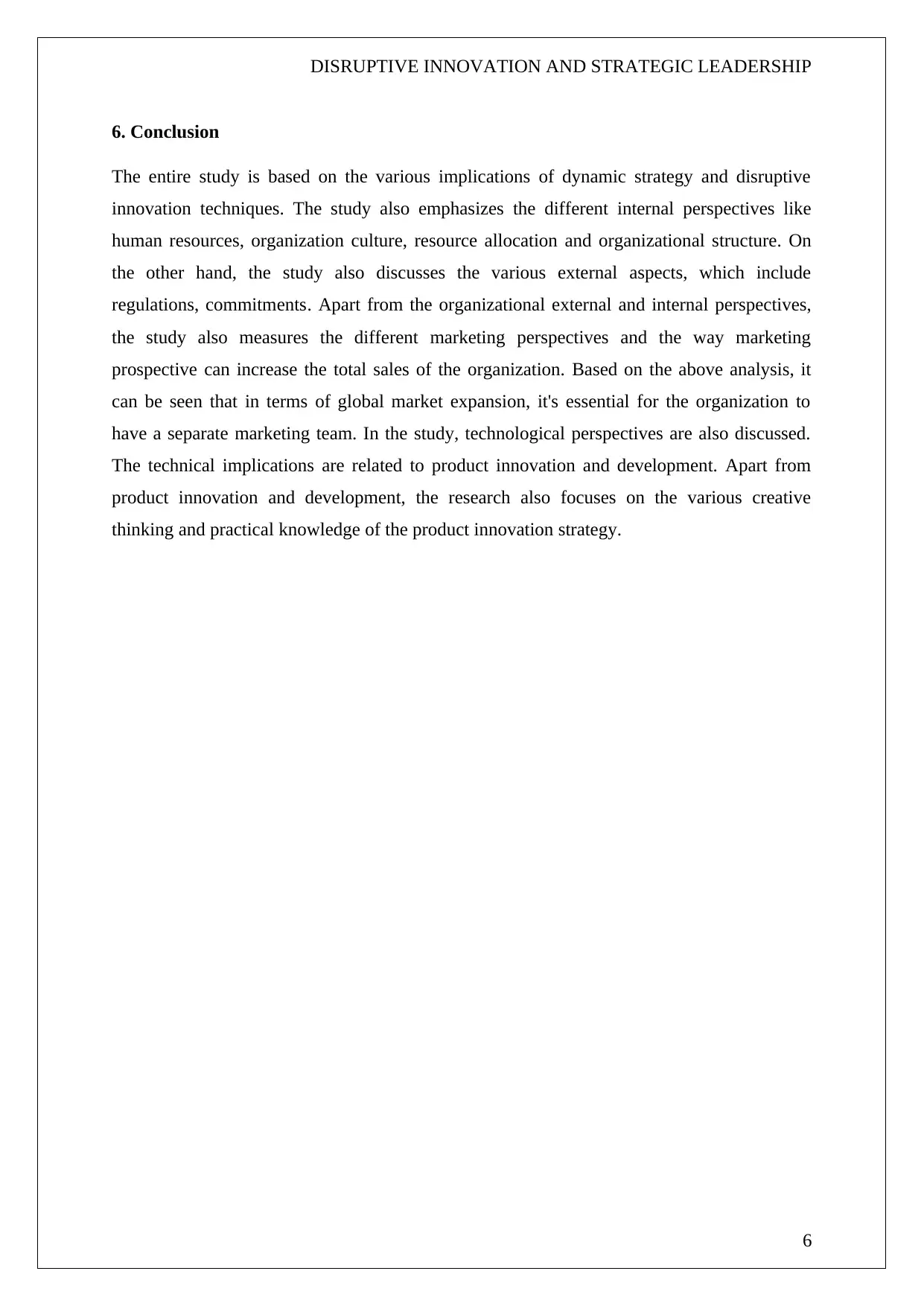
DISRUPTIVE INNOVATION AND STRATEGIC LEADERSHIP
6. Conclusion
The entire study is based on the various implications of dynamic strategy and disruptive
innovation techniques. The study also emphasizes the different internal perspectives like
human resources, organization culture, resource allocation and organizational structure. On
the other hand, the study also discusses the various external aspects, which include
regulations, commitments. Apart from the organizational external and internal perspectives,
the study also measures the different marketing perspectives and the way marketing
prospective can increase the total sales of the organization. Based on the above analysis, it
can be seen that in terms of global market expansion, it's essential for the organization to
have a separate marketing team. In the study, technological perspectives are also discussed.
The technical implications are related to product innovation and development. Apart from
product innovation and development, the research also focuses on the various creative
thinking and practical knowledge of the product innovation strategy.
6
6. Conclusion
The entire study is based on the various implications of dynamic strategy and disruptive
innovation techniques. The study also emphasizes the different internal perspectives like
human resources, organization culture, resource allocation and organizational structure. On
the other hand, the study also discusses the various external aspects, which include
regulations, commitments. Apart from the organizational external and internal perspectives,
the study also measures the different marketing perspectives and the way marketing
prospective can increase the total sales of the organization. Based on the above analysis, it
can be seen that in terms of global market expansion, it's essential for the organization to
have a separate marketing team. In the study, technological perspectives are also discussed.
The technical implications are related to product innovation and development. Apart from
product innovation and development, the research also focuses on the various creative
thinking and practical knowledge of the product innovation strategy.
6
Paraphrase This Document
Need a fresh take? Get an instant paraphrase of this document with our AI Paraphraser
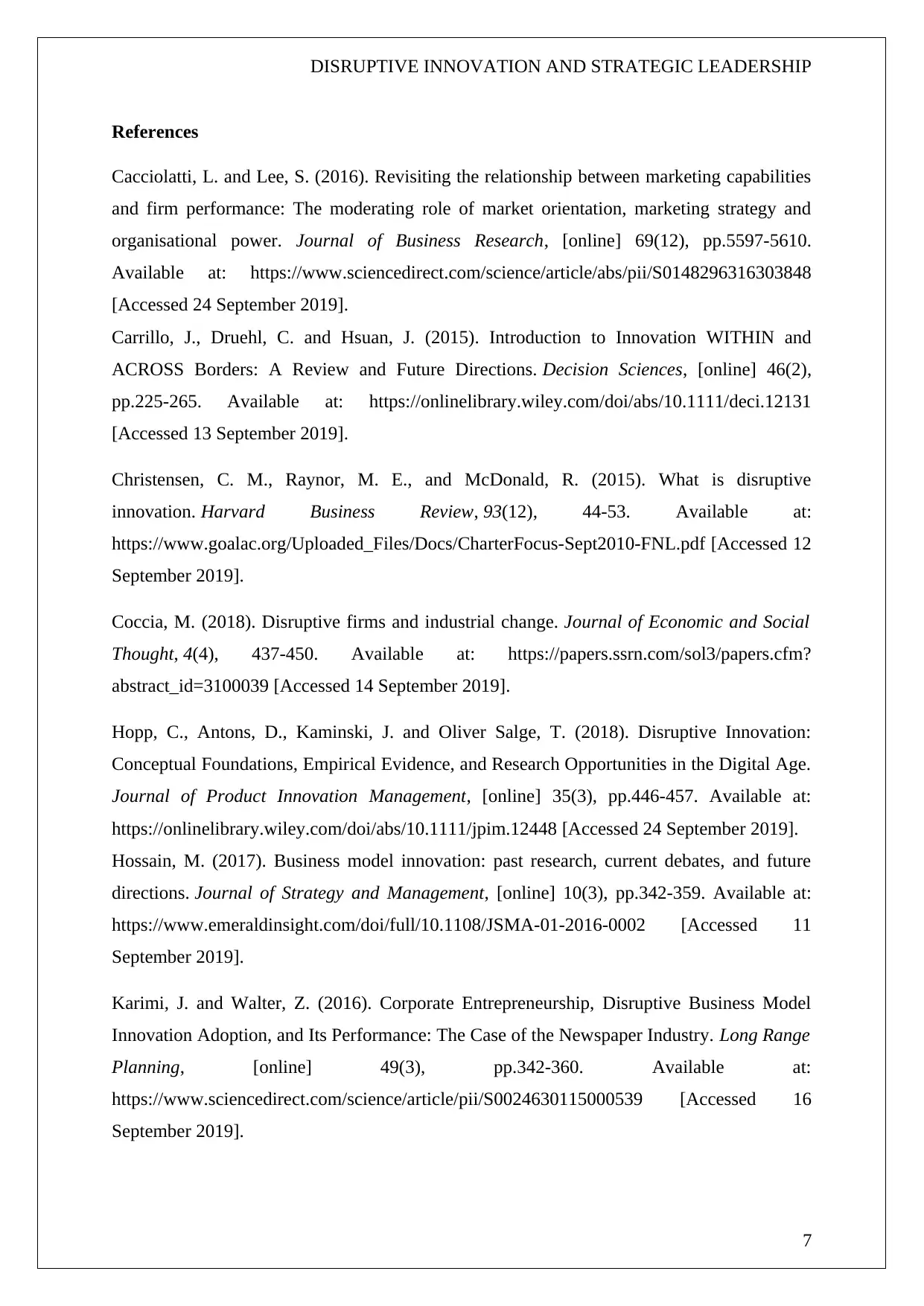
DISRUPTIVE INNOVATION AND STRATEGIC LEADERSHIP
References
Cacciolatti, L. and Lee, S. (2016). Revisiting the relationship between marketing capabilities
and firm performance: The moderating role of market orientation, marketing strategy and
organisational power. Journal of Business Research, [online] 69(12), pp.5597-5610.
Available at: https://www.sciencedirect.com/science/article/abs/pii/S0148296316303848
[Accessed 24 September 2019].
Carrillo, J., Druehl, C. and Hsuan, J. (2015). Introduction to Innovation WITHIN and
ACROSS Borders: A Review and Future Directions. Decision Sciences, [online] 46(2),
pp.225-265. Available at: https://onlinelibrary.wiley.com/doi/abs/10.1111/deci.12131
[Accessed 13 September 2019].
Christensen, C. M., Raynor, M. E., and McDonald, R. (2015). What is disruptive
innovation. Harvard Business Review, 93(12), 44-53. Available at:
https://www.goalac.org/Uploaded_Files/Docs/CharterFocus-Sept2010-FNL.pdf [Accessed 12
September 2019].
Coccia, M. (2018). Disruptive firms and industrial change. Journal of Economic and Social
Thought, 4(4), 437-450. Available at: https://papers.ssrn.com/sol3/papers.cfm?
abstract_id=3100039 [Accessed 14 September 2019].
Hopp, C., Antons, D., Kaminski, J. and Oliver Salge, T. (2018). Disruptive Innovation:
Conceptual Foundations, Empirical Evidence, and Research Opportunities in the Digital Age.
Journal of Product Innovation Management, [online] 35(3), pp.446-457. Available at:
https://onlinelibrary.wiley.com/doi/abs/10.1111/jpim.12448 [Accessed 24 September 2019].
Hossain, M. (2017). Business model innovation: past research, current debates, and future
directions. Journal of Strategy and Management, [online] 10(3), pp.342-359. Available at:
https://www.emeraldinsight.com/doi/full/10.1108/JSMA-01-2016-0002 [Accessed 11
September 2019].
Karimi, J. and Walter, Z. (2016). Corporate Entrepreneurship, Disruptive Business Model
Innovation Adoption, and Its Performance: The Case of the Newspaper Industry. Long Range
Planning, [online] 49(3), pp.342-360. Available at:
https://www.sciencedirect.com/science/article/pii/S0024630115000539 [Accessed 16
September 2019].
7
References
Cacciolatti, L. and Lee, S. (2016). Revisiting the relationship between marketing capabilities
and firm performance: The moderating role of market orientation, marketing strategy and
organisational power. Journal of Business Research, [online] 69(12), pp.5597-5610.
Available at: https://www.sciencedirect.com/science/article/abs/pii/S0148296316303848
[Accessed 24 September 2019].
Carrillo, J., Druehl, C. and Hsuan, J. (2015). Introduction to Innovation WITHIN and
ACROSS Borders: A Review and Future Directions. Decision Sciences, [online] 46(2),
pp.225-265. Available at: https://onlinelibrary.wiley.com/doi/abs/10.1111/deci.12131
[Accessed 13 September 2019].
Christensen, C. M., Raynor, M. E., and McDonald, R. (2015). What is disruptive
innovation. Harvard Business Review, 93(12), 44-53. Available at:
https://www.goalac.org/Uploaded_Files/Docs/CharterFocus-Sept2010-FNL.pdf [Accessed 12
September 2019].
Coccia, M. (2018). Disruptive firms and industrial change. Journal of Economic and Social
Thought, 4(4), 437-450. Available at: https://papers.ssrn.com/sol3/papers.cfm?
abstract_id=3100039 [Accessed 14 September 2019].
Hopp, C., Antons, D., Kaminski, J. and Oliver Salge, T. (2018). Disruptive Innovation:
Conceptual Foundations, Empirical Evidence, and Research Opportunities in the Digital Age.
Journal of Product Innovation Management, [online] 35(3), pp.446-457. Available at:
https://onlinelibrary.wiley.com/doi/abs/10.1111/jpim.12448 [Accessed 24 September 2019].
Hossain, M. (2017). Business model innovation: past research, current debates, and future
directions. Journal of Strategy and Management, [online] 10(3), pp.342-359. Available at:
https://www.emeraldinsight.com/doi/full/10.1108/JSMA-01-2016-0002 [Accessed 11
September 2019].
Karimi, J. and Walter, Z. (2016). Corporate Entrepreneurship, Disruptive Business Model
Innovation Adoption, and Its Performance: The Case of the Newspaper Industry. Long Range
Planning, [online] 49(3), pp.342-360. Available at:
https://www.sciencedirect.com/science/article/pii/S0024630115000539 [Accessed 16
September 2019].
7
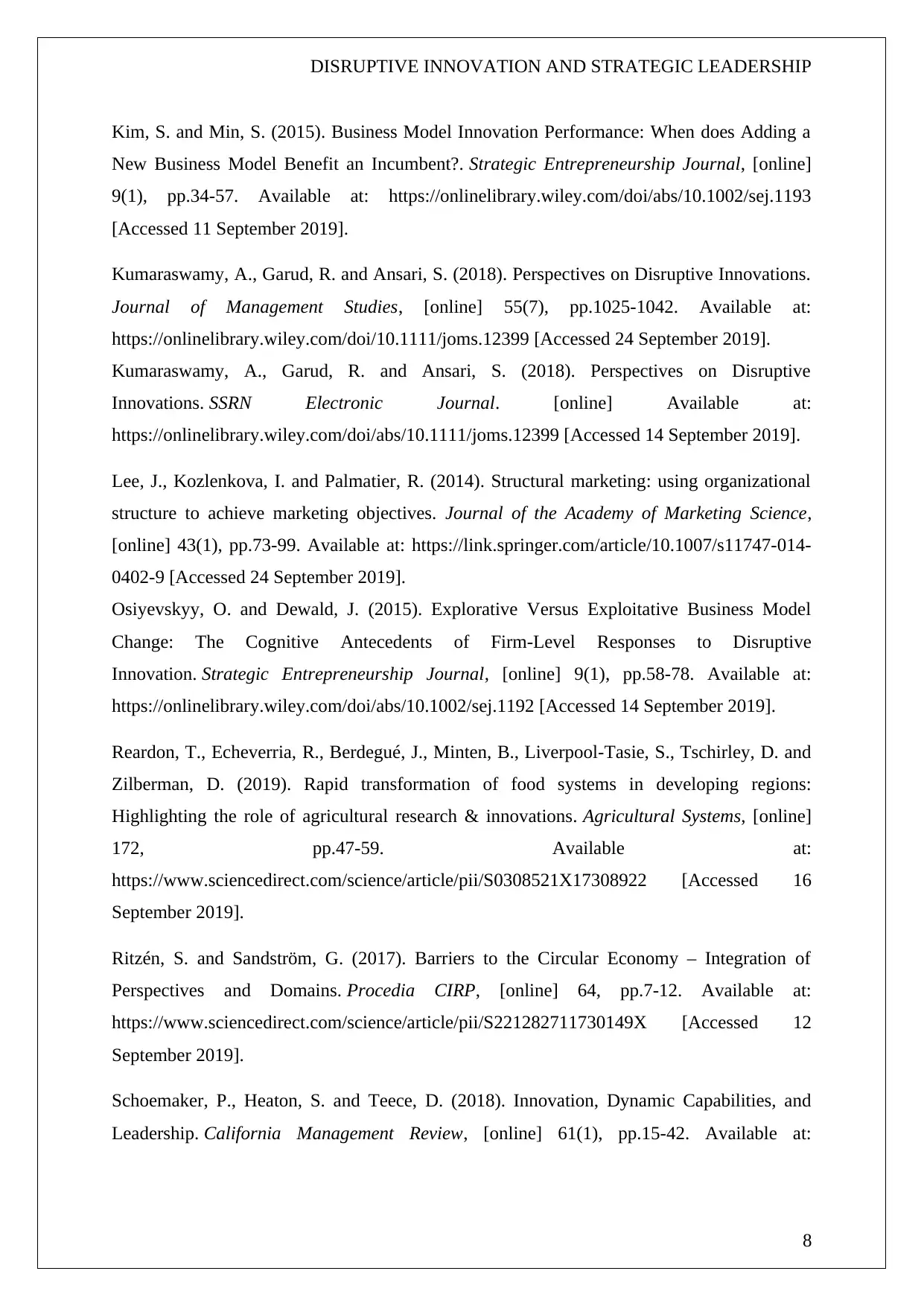
DISRUPTIVE INNOVATION AND STRATEGIC LEADERSHIP
Kim, S. and Min, S. (2015). Business Model Innovation Performance: When does Adding a
New Business Model Benefit an Incumbent?. Strategic Entrepreneurship Journal, [online]
9(1), pp.34-57. Available at: https://onlinelibrary.wiley.com/doi/abs/10.1002/sej.1193
[Accessed 11 September 2019].
Kumaraswamy, A., Garud, R. and Ansari, S. (2018). Perspectives on Disruptive Innovations.
Journal of Management Studies, [online] 55(7), pp.1025-1042. Available at:
https://onlinelibrary.wiley.com/doi/10.1111/joms.12399 [Accessed 24 September 2019].
Kumaraswamy, A., Garud, R. and Ansari, S. (2018). Perspectives on Disruptive
Innovations. SSRN Electronic Journal. [online] Available at:
https://onlinelibrary.wiley.com/doi/abs/10.1111/joms.12399 [Accessed 14 September 2019].
Lee, J., Kozlenkova, I. and Palmatier, R. (2014). Structural marketing: using organizational
structure to achieve marketing objectives. Journal of the Academy of Marketing Science,
[online] 43(1), pp.73-99. Available at: https://link.springer.com/article/10.1007/s11747-014-
0402-9 [Accessed 24 September 2019].
Osiyevskyy, O. and Dewald, J. (2015). Explorative Versus Exploitative Business Model
Change: The Cognitive Antecedents of Firm-Level Responses to Disruptive
Innovation. Strategic Entrepreneurship Journal, [online] 9(1), pp.58-78. Available at:
https://onlinelibrary.wiley.com/doi/abs/10.1002/sej.1192 [Accessed 14 September 2019].
Reardon, T., Echeverria, R., Berdegué, J., Minten, B., Liverpool-Tasie, S., Tschirley, D. and
Zilberman, D. (2019). Rapid transformation of food systems in developing regions:
Highlighting the role of agricultural research & innovations. Agricultural Systems, [online]
172, pp.47-59. Available at:
https://www.sciencedirect.com/science/article/pii/S0308521X17308922 [Accessed 16
September 2019].
Ritzén, S. and Sandström, G. (2017). Barriers to the Circular Economy – Integration of
Perspectives and Domains. Procedia CIRP, [online] 64, pp.7-12. Available at:
https://www.sciencedirect.com/science/article/pii/S221282711730149X [Accessed 12
September 2019].
Schoemaker, P., Heaton, S. and Teece, D. (2018). Innovation, Dynamic Capabilities, and
Leadership. California Management Review, [online] 61(1), pp.15-42. Available at:
8
Kim, S. and Min, S. (2015). Business Model Innovation Performance: When does Adding a
New Business Model Benefit an Incumbent?. Strategic Entrepreneurship Journal, [online]
9(1), pp.34-57. Available at: https://onlinelibrary.wiley.com/doi/abs/10.1002/sej.1193
[Accessed 11 September 2019].
Kumaraswamy, A., Garud, R. and Ansari, S. (2018). Perspectives on Disruptive Innovations.
Journal of Management Studies, [online] 55(7), pp.1025-1042. Available at:
https://onlinelibrary.wiley.com/doi/10.1111/joms.12399 [Accessed 24 September 2019].
Kumaraswamy, A., Garud, R. and Ansari, S. (2018). Perspectives on Disruptive
Innovations. SSRN Electronic Journal. [online] Available at:
https://onlinelibrary.wiley.com/doi/abs/10.1111/joms.12399 [Accessed 14 September 2019].
Lee, J., Kozlenkova, I. and Palmatier, R. (2014). Structural marketing: using organizational
structure to achieve marketing objectives. Journal of the Academy of Marketing Science,
[online] 43(1), pp.73-99. Available at: https://link.springer.com/article/10.1007/s11747-014-
0402-9 [Accessed 24 September 2019].
Osiyevskyy, O. and Dewald, J. (2015). Explorative Versus Exploitative Business Model
Change: The Cognitive Antecedents of Firm-Level Responses to Disruptive
Innovation. Strategic Entrepreneurship Journal, [online] 9(1), pp.58-78. Available at:
https://onlinelibrary.wiley.com/doi/abs/10.1002/sej.1192 [Accessed 14 September 2019].
Reardon, T., Echeverria, R., Berdegué, J., Minten, B., Liverpool-Tasie, S., Tschirley, D. and
Zilberman, D. (2019). Rapid transformation of food systems in developing regions:
Highlighting the role of agricultural research & innovations. Agricultural Systems, [online]
172, pp.47-59. Available at:
https://www.sciencedirect.com/science/article/pii/S0308521X17308922 [Accessed 16
September 2019].
Ritzén, S. and Sandström, G. (2017). Barriers to the Circular Economy – Integration of
Perspectives and Domains. Procedia CIRP, [online] 64, pp.7-12. Available at:
https://www.sciencedirect.com/science/article/pii/S221282711730149X [Accessed 12
September 2019].
Schoemaker, P., Heaton, S. and Teece, D. (2018). Innovation, Dynamic Capabilities, and
Leadership. California Management Review, [online] 61(1), pp.15-42. Available at:
8
⊘ This is a preview!⊘
Do you want full access?
Subscribe today to unlock all pages.

Trusted by 1+ million students worldwide
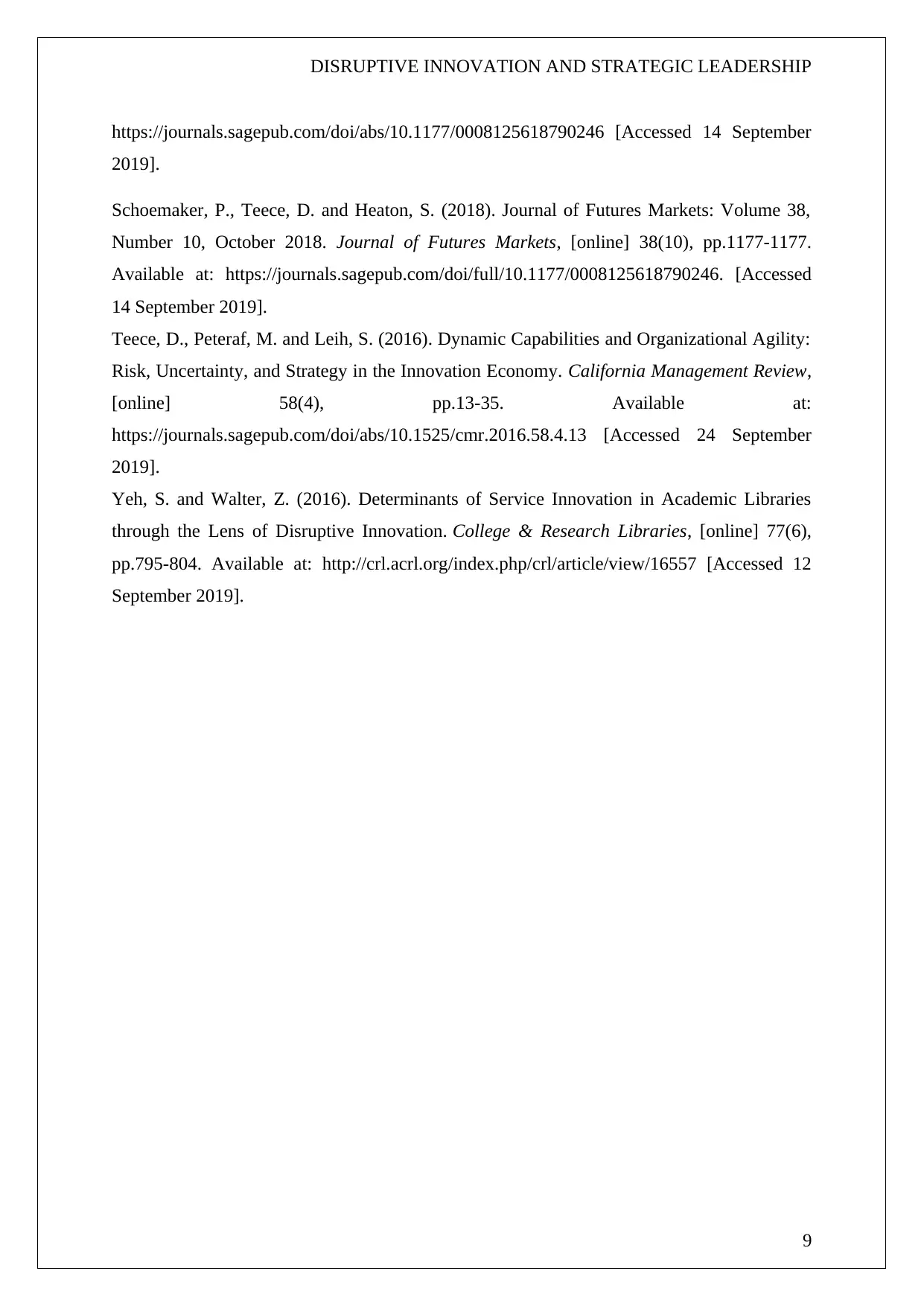
DISRUPTIVE INNOVATION AND STRATEGIC LEADERSHIP
https://journals.sagepub.com/doi/abs/10.1177/0008125618790246 [Accessed 14 September
2019].
Schoemaker, P., Teece, D. and Heaton, S. (2018). Journal of Futures Markets: Volume 38,
Number 10, October 2018. Journal of Futures Markets, [online] 38(10), pp.1177-1177.
Available at: https://journals.sagepub.com/doi/full/10.1177/0008125618790246. [Accessed
14 September 2019].
Teece, D., Peteraf, M. and Leih, S. (2016). Dynamic Capabilities and Organizational Agility:
Risk, Uncertainty, and Strategy in the Innovation Economy. California Management Review,
[online] 58(4), pp.13-35. Available at:
https://journals.sagepub.com/doi/abs/10.1525/cmr.2016.58.4.13 [Accessed 24 September
2019].
Yeh, S. and Walter, Z. (2016). Determinants of Service Innovation in Academic Libraries
through the Lens of Disruptive Innovation. College & Research Libraries, [online] 77(6),
pp.795-804. Available at: http://crl.acrl.org/index.php/crl/article/view/16557 [Accessed 12
September 2019].
9
https://journals.sagepub.com/doi/abs/10.1177/0008125618790246 [Accessed 14 September
2019].
Schoemaker, P., Teece, D. and Heaton, S. (2018). Journal of Futures Markets: Volume 38,
Number 10, October 2018. Journal of Futures Markets, [online] 38(10), pp.1177-1177.
Available at: https://journals.sagepub.com/doi/full/10.1177/0008125618790246. [Accessed
14 September 2019].
Teece, D., Peteraf, M. and Leih, S. (2016). Dynamic Capabilities and Organizational Agility:
Risk, Uncertainty, and Strategy in the Innovation Economy. California Management Review,
[online] 58(4), pp.13-35. Available at:
https://journals.sagepub.com/doi/abs/10.1525/cmr.2016.58.4.13 [Accessed 24 September
2019].
Yeh, S. and Walter, Z. (2016). Determinants of Service Innovation in Academic Libraries
through the Lens of Disruptive Innovation. College & Research Libraries, [online] 77(6),
pp.795-804. Available at: http://crl.acrl.org/index.php/crl/article/view/16557 [Accessed 12
September 2019].
9
1 out of 10
Related Documents
Your All-in-One AI-Powered Toolkit for Academic Success.
+13062052269
info@desklib.com
Available 24*7 on WhatsApp / Email
![[object Object]](/_next/static/media/star-bottom.7253800d.svg)
Unlock your academic potential
Copyright © 2020–2025 A2Z Services. All Rights Reserved. Developed and managed by ZUCOL.





